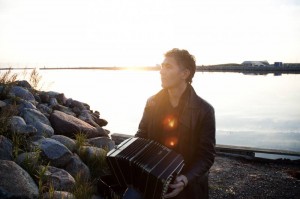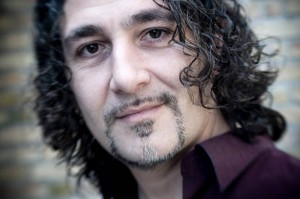 After the composition, deeply interested in multiple musical languages, Paolo Russo is a formidable bandoneon specialist. His charming, realistic, rare and evocative playing is the son of a communion apologue on genres such as classical music, so much Argentine and jazz, all adorned with extravagant Nordic colours by intense emotional. Through this interview, Russo tells us his life as a musician.
After the composition, deeply interested in multiple musical languages, Paolo Russo is a formidable bandoneon specialist. His charming, realistic, rare and evocative playing is the son of a communion apologue on genres such as classical music, so much Argentine and jazz, all adorned with extravagant Nordic colours by intense emotional. Through this interview, Russo tells us his life as a musician.
You were born in Pescara, where you started your first academic studies. But at 27 years old you moved to Denmark, namely to Copenhagen. What were the triggering factors that pushed you to abandon Italy?
I had a strong desire to expand my knowledge and to confront me with a different, richer and lively music environment with new stimuli and a social dimension that is more congenial to me. Therefore, after a couple of intensive recurrences lasting several months, both in winter and summer, I decided to move and try to enter as a student of the Rytmisk Musikkonservatorium. Having passed the admission exam, at the very selective time (1997), and entering the class of soloists, has certainly contributed to giving me great security, a clear sense of direction and focus, showing me that the way was the right one. The five year course of study allowed me not only to face considerable technical/musical growth (coming to contact with some of the most important jazz, folk, pop and contemporary musicians worldwide), but also to establish a network with the local music environment and, consequently, with a growing frequency on the Scandinavian scene.
In our country, unfortunately, even the professional musician is considered, mistakenly, only a hobbyst, even for the institutions. In many other countries, especially in Northern Europe, the artist is like any other practitioner, from the doctor to the lawyer, from the engineer to the accountant. Do you think this conception depends on a different cultural and social background?
I think the figure of the musician, outside the classical/opera environment and the circuits related to pop music, is the same somewhat. Sure, in Scandinavia, things are a bit different, as the whole society is organized differently. There are many associations, structures responsible for the development and implementation of projects, a state fund intended to support the various activities of musicians, composers and producers, whether they are design or research. Finally, also private funds and associations. This undoubtedly allows for a greater range of creative action and promotes the programming of a broader musical activity, sometimes even with the involvement of international musicians. However, despite the fact that paper appears to be very beneficial, sometimes it is likely to be a kind of institutional or para-institutional screen behind which to hide weaknesses and insecurities linked to its artistic choices. For a long time, I have been aiming for as much as possible on a design autonomy, which allows me to be faithful to the most direct expression of my aesthetics.
You studied in New York with US pianist Richie Beirach and in Buenos Aires with Argentine bandoneonist Nestor Marconi. Since 2001 you have been devoted to bandoneon. What are the peculiarities of this instrument that conquisted you so close to focusing your attention on it?
I had approached the 32-year-old bandoneon studio, on the one hand it represented a major challenge in terms of approach and decoding of this particularly complicated and illogical instrument (in a country where it is uncommon and Known), on the other, supported by the extensive piano study, both in classical and jazz, has allowed me to conduct a research mainly focused on deepening the technical and sound aspect. It is precisely in the sound and expressive possibilities of bandoneon that I dive on a daily basis. I feel that its voice is well suited to express and represent my inner world. The encounter and study with two such great jazz and tango personalities as Richie Beirach in New York (1995) and more prolific and more advanced with Nestor Marconi in Buenos Aires (2004-2013). I was surely of great help, as did the music guide of my piano teacher, the great Rachel Marchegiani, from whom I learned the instrumental bases, love for the piano, for music in general, and discipline in the studio. For this I will always be immensely grateful to her.
Your playing is knowledgently contaminated, the result of a syncretism by the grungy spirit that embraces Mediterranean music, Nordic crepuscular soundtracks and imaginations, combined with colouring that admirers jazz. Is this mingling the real manifest of your distinctive figure?
Musical and human experiences inevitably come together in their own artistic output. A creative mind cannot fail to be fascinated by the different influences and expressive ways it comes into contact with. But then the difficulty lies in the ability to make own voice distinct and unique, though impregnated and rich in more or less recognizable references. If I had to choose one word to synthesize my artistic and expressive poster I would say “authenticity”.
You are very prolific also as a composer. How do your original songs take shape?
I love the compositional process, because here feelings, emotions and ideas are formed, regardless of the constraints imposed by styles and genres. It is an act of faith towards oneself. You have to be confident in the uniqueness of your message. I never strive to be original, I do not think the right path is that. I support, however, that intellectual honesty, artistic integrity and expressive authenticity are the most important features. The originality of their own music will inevitably result from them. The piano still remains the central element around which my entire composer’s work is gravitated, but sometimes the initial idea can also simply arise from a fragment played on bandoneon or even purely imagined. Anyway, I always try to throw down the main ideas on paper and pencil, with piano writing, even if it’s more extensive ensemble pieces than just defining the overall structure of composition. I crave the development of the song and the orchestration in a second stage. I did so for my two new works: “Tangology”, eleven octopus-inspired tango movements (the CD was released in June 2017 in Denmark for “Storyville”) along with the wonderful MidtVest ensemble and “Imaginary Soundtrack” Suites for a rather unusual quartet (flute, vibraphone, bandoneon and double bass) in fifteen movements, inspired by the world of Italian music, presented in Holland and Denmark in 2016.
You have often performed as a soloist for string orchestras and symphony orchestras. Is this a dimension that is I do not consider myself an interpreter in the common sense of the term. Certainly, I’m sorry not to play the music of others, I do it occasionally and with pleasure, but my activity with orchestras and ensembles is mainly focused on the proposal of original material: here is the context I feel I can do best.
A close collaboration since the beginning of this year particularly appealing to you from an artistic point of view?
I do not consider myself an interpreter in the common sense of the term. Certainly I’m sorry not to play the music of others, I do it occasionally and with pleasure, but my activity with orchestras and ensembles is mainly focused on the proposal of original material: here is the context I feel I can do best.
 Your invaluable talent has allowed you to collaborate also in theatre and television. What role did you cover in these circumstances?
Your invaluable talent has allowed you to collaborate also in theatre and television. What role did you cover in these circumstances?
I worked in some theatrical performances in the early 2000s (I was still a student at the Copenhagen Conservatory) as a composer and stage musician. On television, except for some sporadic interventions in several live broadcasts, I wrote in 2012 the music for a successful Danish sit-com in Denmark and in the world: “Klovn”. In addition, an interesting parallel between the difficulties in learning such a strange instrument as bandoneon and the adversity and paradoxes that sometimes arise in life is represented by Arun Sharma’s short-film “The illogical instrument” (2002), in which I play as a protagonist with my wife and as the author of the soundtrack.
Throughout your excellent career, you have released eleven albums as a leader, while you’ve been guest in over fifty albums made by a number of musicians. How do you live and interpret sideman’s activity?
I worked hard as sideman and it is a role I know well. For a decade, however, I have clearly shifted my range of action as I’m more interested in investing time in research, composition, and deepening rather than playing so much in projects and situations in which their own possibilities remain almost unexpressed. I believe that to develop your own voice takes time, dedication, humility, curiosity and passion.
Do you think that Copenhagen is your ultimate goal or would you decide to return to Italy in the future?
Copenhagen, of course, is a city where I am very well. Not too big, not too small and growing in many respects: urban, social, infrastructural, and in terms of the cultural environment. Sure, it is not Paris, London, Berlin or New York, but I love measuring the quality of life by taking into account other factors as well. Italy is a pleasant place for me to stay always very happy, a place of affection, family, memories, still very close to me in culture, in the management of human relationships, in the importance of language. However, at the moment, I still have no clue as to whether I’m going to go live permanently. Today, I believe that a musician should know how to combine the concepts of flexibility and mobility, to work in a wider, richer, and engaging space.
Are you creating a new record project?
Yes, the next record (the twelfth on my name) on official release in Denmark on 5th October 2017 will be my “Bandoneon Solo – Vol. II”, second volume of a cycle of publications devoted to the tempting attempt to investigate further expressive possibilities of this wonderful instrument (which, in my opinion, still has a lot to say) that I started in December 2015, with Vol. I, devoted entirely to the interpretation of jazz standards. In the second volume, however, I will only present original pieces, written specifically for bandoneon (diatonic or better double sound), with large spaces devoted to improvisation. At the same time, the publication of the anthology with the scores is planned. The next project will be dedicated to the live performance and following the recording of the work “Eskar Trio meets Paolo Russo” (violin, violoncello, piano and bandoneon), with all my compositions that I will perform together with a formidable classical Danish trio with which I collaborate.
Questo post è disponibile anche in: Italian

 English
English Italiano
Italiano 





Leave a comment
You must be logged in to post a comment.